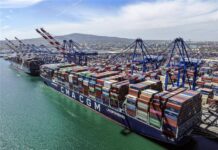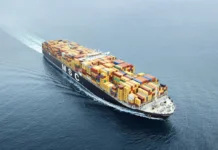
Energy markets, global trade stakeholders and the international freight industry were bracing for Iran’s response to US strikes on its nuclear sites early this week. The various retaliation scenarios included Iran’s possible closure of the Strait of Hormuz, which could have significant implications for all of the above.
Late Monday though, following a measured Iranian attack on a US military base in the region, President Trump announced that a ceasefire would go into effect Tuesday morning. At the moment the ceasefire seems tenuous, but if it does take hold, those feared disruptions to oil markets and logistics could be averted.
But even during the past twelve days of conflict tanker flows through the Strait of Hormuz remained for the most part normal as did operations at Dubai’s Port of Jebel Ali, the major regional transhipment port and the key sea – air hub for containers arriving from the Far East and continuing on to Europe and N. America by air.
And in Israel, the ports of Haifa and Ashdod likewise remained operational throughout, with Freightos Terminal showing no container rate volatility for Israeli lanes, though some carriers diverted away from the northern port of Haifa in favor of Ashdod. The ceasefire is also restoring air cargo capacity to the Gulf region after some airspace closures on Monday.
With this Middle East crisis and its implications for trade possibly deescalating, attention will turn back to the US trade war and the looming tariff pause expirations. Countries other than China facing US reciprocal tariffs announced in April have only until July 9th to reach agreements or face possible duty hikes.
And aside from a tentative agreement with the UK, the US still reports only limited progress in negotiations with many of its largest trading partners like the EU, Canada, and Vietnam. President Trump has said that the White House may apply tariffs unilaterally if deals don’t materialize in time, though other administration officials state that it may extend tariff pauses for countries it considers to be negotiating in good faith.
About two weeks ago President Trump announced that a trade deal with China – that would keep the baseline US tariff on China at 30% – was about to be finalized though few developments or details have emerged since then. FreightWaves reports though that while the 10% reciprocal tariff will apply to all Chinese exports, the 20% tariffs aimed at fentanyl shipments will only apply to a limited list of fentanyl-related goods. Many goods will still also be subject to other tariffs like 301 duties already in place or other sectoral tariffs.
In the meantime, the initial demand surge post the May 12th China-US deescalation and ahead of the August 12th deadline for the reduced US tariffs on China may be behind us. At the same time, carriers, expecting a stronger and more prolonged transpacific container volume spike, have increased capacity on the lane by 13% compared to March and early April.
Easing demand and growing capacity are combining to push container spot rates down sharply, especially to the West Coast where carriers added the most capacity. Transpacific rates to the West Coast eased 7% last week, but daily rates are down to about $3,500/FEU compared to about $5,800/FEU just a week ago. Freightos Terminal Shanghai – Long Beach prices of about $3,700/FEU are about back to their late May levels. Daily rates to the East Coast are down to $6,300/FEU from a high of $7,200/FEU a week ago.
Asia – Europe rates increased 6% last week to about $3,100/FEU but seem to be leveling off, with Asia – Mediterranean prices down 9% to $4,400/FEU and about back to their early-June level. These rate trends suggest that – despite the start of peak season demand, some capacity shift to the transpacific and persistent congestion – market conditions are not supporting mid-month rate increases. With these signs of easing though, prices are still 30% higher than at the end of May for Asia – Europe and nearly 50% higher for Asia – Mediterranean.
In air cargo, Freightos Air Index rate data show that prices are easing slightly but are stable overall for the major lanes. Flight cancellations in the Middle East may have contributed to Middle East – N. America rates climbing to $3.00/kg last week from their baseline of about $2.50/kg since mid-May, though rates for many other Middle East lanes went unchanged.





